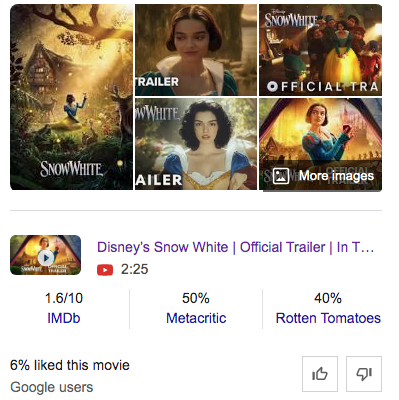Disney has long been known for its powerhouse marketing campaigns, turning movies like Frozen and The Lion King into billion-dollar franchises. But not every Disney movie gets the full red-carpet treatment—some are left with minimal promotion, bad release timing or outright neglect.
The latest example is the 2025 live-action Snow White remake, which has turned into a box office disaster. With poor audience reception, weak marketing and behind-the-scenes controversy, the movie’s failure isn’t surprising—it feels like Disney saw the writing on the wall long before it hit theaters. The film cost Disney a whopping $269.4 million while only grossing $16 million on opening day. As of now the movie has a 40% rating on rotten tomatoes
So how does Disney decide which movies get full support and which are left to sink?
Disney Picks Its Favorites—And Snow White Wasn’t One of Them
When Disney believes a movie is a guaranteed hit, they throw everything behind it: trailers, merchandise, press tours and nonstop social media hype. That’s why films like The Little Mermaid (2023), despite mixed reactions, still got a massive marketing push.
But Snow White? The signs of minimal effort were there early on:
- A delayed, underwhelming trailer drop with little fanfare
- A lack of merchandise tie-ins, which is rare for a Disney princess movie
- A quiet marketing campaign compared to past live-action remakes
- No major promotional tie-ins, like McDonald’s Happy Meal toys, which even smaller Disney films usually get
This suggests that Disney may have internally given up on the film before it even released—choosing to spend their marketing dollars elsewhere.
A PR Disaster Didn’t Help
Marketing disasters can sink a movie before it even debuts, and Snow White was a PR nightmare from the start. The lead actress, Rachel Zegler, faced backlash over past interviews where she criticized the original 1937 film, and Disney’s decision to replace the iconic Seven Dwarfs with a diverse group of “magical creatures” sparked controversy.
Instead of managing the backlash effectively, Disney went quiet—a sign that they were distancing themselves from the film rather than trying to fix its image.
Bad Release Timing and Minimal Support
Disney also set Snow White up for failure by choosing a release window with heavy competition. Unlike The Lion King (2019), which dominated summer box offices, Snow White was released at a time when other blockbusters were pulling in bigger audiences.
Combine that with minimal early screenings, weak press tours, and little fan engagement, and it became clear: Disney wasn’t going all in on this one.
The Snow White Effect: A Pattern of Selective Marketing
This isn’t the first time Disney has seemingly let a film flop due to weak marketing. Movies like Strange World (2022) and Raya and the Last Dragon (2021) suffered from low promotional efforts, while The Princess and the Frog (2009) received less attention than Tangled (2010), despite being a major Disney Princess film.
Disney has a pattern of favoring CGI over hand-drawn animation, prioritizing movies with strong franchise potential and distancing itself from projects that receive early backlash.
Did Disney Intentionally Let Snow White Fail?
While it’s impossible to say if Disney wanted Snow White to bomb, they certainly didn’t do much to help it succeed. With a weak marketing push, PR missteps, and poor timing, the movie had the odds stacked against it.
At the end of the day, Disney chooses its winners and losers—and Snow White (2025) ended up in the losing category. Whether the company will learn from this or continue to push out half-hearted remakes remains to be seen.
by Jayla Jones

